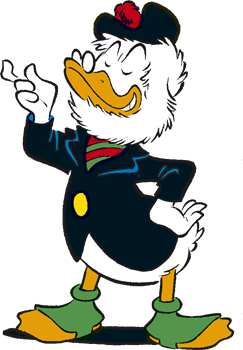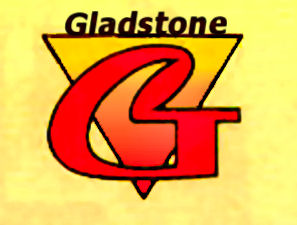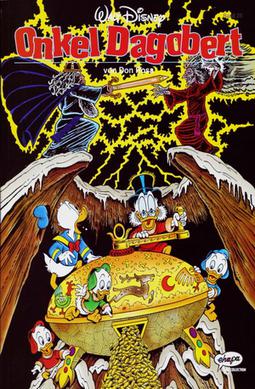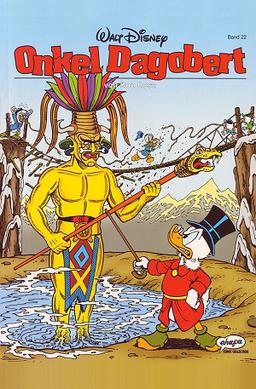Plot
Gyro Gearloose has invented a "universal solvent", a thick, black liquid capable of instantly dissolving anything except diamonds, with it then transforming the dissolved matter into super dense dust. Gyro then keeps the Universal Solvent (referred to as "Omnisolve") in a diamond jar and on an Omnisolve beach umbrella (where a sublayer of diamond dust keeps it from dissolving the umbrella itself). Scrooge McDuck buys the solvent from him, intending on using it for mining, in order to gain the super pure diamonds located in the outer core of the Earth. However, when journalists at a press conference are unappreciative, an angered Scrooge decides to make an impromptu demonstration of the solvent. He carelessly pours it directly onto the ground, where it begins to make a solid shaft all the way down to the centre of the Earth (due to the Omnisolve creating a super-strong and dense lining on the sides of the shaft wall).
After Donald's nephews explain the potentially catastrophic impact of this act - it would eventually lead to the Earth's destruction by destroying the planet's electromagnetic field and causing the Earth to be bombarded with radioactive solar winds - Scrooge, Donald, and the boys go on a quest down the shaft to retrieve the solvent.
They first start slowly going down with a descent platform created by Gyro. In order to stop the air pressure from crushing them, Gyro creates an airlock over the shaft, making the shaft a vacuum, meaning they cannot eat, much to Donald's comical misery. Their platform is also slightly damaged by a falling pebble (which, due to the vacuum having no air to slow it down, was essentially travelling at bullet speed). Scrooge also finds his diamonds, although he is nearly burned by the massive heat of the diamonds, as they were in the outer core. Later, as Scrooge finds out, they become essentially weightless, due to their weight being their attraction to the Earth's mass, and as they travel deeper, more of the Earth is above them than below them, making them almost weightless. They also find out that they have reached a section of the shaft still with air, meaning that they can now eat, much to Donald's glee.
Eventually, they reach the center and, after Scrooge is nearly killed by the Omnisolve, they are able to contain the Universal Solvent. However, the magma from inside the earth mantle will soon break through the shaft, making them have to use propulsion rockets to escape through inner space. Donald has his helmet destroyed by a falling pebble, but still survives, due to air leaking in from cracks. They soon find that the magma is destroying the shaft from the bottom up, and the top of the shaft is collapsing. They are able to escape aided by the Omnisolve umbrella, which saves them from the falling rocks and allows them to create an escape route, but unfortunately, the magma is able to follow them. They eventually find themselves in Terry Fermy, with the Terries and Ferrmies destroying a rock column, forcing them to use another escape route. They eventually find themselves under the Tulebug River, with the river water solidifying the magma.
They then arrive at the Money Bin (given a lift by Gus Goose), with the top of the shaft about to erupt like a volcano. Gyro is able to stop the eruption with the Omnisolve umbrella, which causes the magma to be reduced into a super-dense dust that kept falling back on itself. Scrooge also gets the super-pure diamonds he wanted in the first place (due to them being carried by the magma, but the Omnisolve umbrella could not destroy them). Scrooge's Money Bin is also safe, although it is severely tilted, with Scrooge musing he could still have his workers work there by "wearing some special shoes". In the end, Scrooge deems the solvent as a failed investment. While it did succeed in getting him thousands of flawless diamonds from the bowels of the Earth, he didn't take into account that these diamonds are super-dense, and thus even the smallest ones weigh over 100 kg (200 pounds) each, making them useless as jewellery. He then destroys the Omnisolve notes with the Omnisolve itself, much to Gyro's relief.

Gyro Gearloose is a cartoon character created in 1952 by Carl Barks for Disney comics. An anthropomorphic chicken, he is part of the Donald Duck universe, appearing in comic book stories as a friend of Donald Duck, Scrooge McDuck, and anyone who is associated with them. He was also featured in the animated series DuckTales. Gyro first appeared in the Carl Barks comic "Gladstone's Terrible Secret", and was the regular lead character in 4-page backup stories in Barks' issues of Uncle Scrooge, starting with issue #13 and continuing through #41.

Flintheart Glomgold is a cartoon character created in 1956 by Carl Barks. He is a South African American Pekin Duck and the business rival of Scrooge McDuck, usually portrayed as an ambitious, ruthless, and manipulative businessman who shares many of the same qualities as Scrooge—the drive for massive wealth, and the cunning and creativity to obtain the same—but he lacks any of Scrooge's tendencies towards generosity and compassion. In Don Rosa's The Life and Times of Scrooge McDuck, he is said to be a Boer.

The Donald Duck universe is a fictional shared universe which is the setting of stories involving Disney cartoon character Donald Duck, as well as Daisy Duck, Huey, Dewey, and Louie, Scrooge McDuck, and many other characters. Life in the Donald Duck universe centers on the city of Duckburg and is a part of the larger Mickey Mouse universe. In addition to the original comic book stories by Carl Barks, the Duckburg cast was featured in Little Golden Books, television series such as DuckTales (1987–1991), Darkwing Duck (1991–1992), and the DuckTales reboot (2017–2021), and video games such as DuckTales (1989), QuackShot (1991), Goin' Quackers (2000), and DuckTales: Remastered (2013).

Gladstone Publishing was an American company that published Disney comics from 1986 to 1990 and from 1993 to 1998. The company had its origins as a subsidiary of Another Rainbow Publishing, a company formed by Bruce Hamilton and Russ Cochran to publish the Carl Barks Library and produce limited edition lithographs of Carl Barks oil paintings of the Disney ducks. The name references Gladstone Gander.

"The Quest for Kalevala" is a 1999 Uncle Scrooge comic book story written and drawn by Don Rosa. The story was first published in the Danish Anders And & Co. #1999-48; the first American publication was in Uncle Scrooge #334, in October 2004.

"Land Beneath the Ground!" is a Scrooge McDuck comic book story that appeared in 1956 in the comic book Uncle Scrooge, written by Carl Barks.

Travelling to the Earth's center is a popular theme in science fiction. Some subterranean fiction involves traveling to the Earth's center and finding either a hollow Earth or Earth's molten core. Planetary scientist David J. Stevenson suggested sending a probe to the core as a thought experiment. Humans have drilled over 12 kilometers in the Sakhalin-I project. In terms of depth below the surface, the Kola Superdeep Borehole SG-3 retains the world record at 12,262 metres (40,230 ft) in 1989 and still is the deepest artificial point on Earth.

"A Little Something Special" is a 1997 Disney comics story created by Don Rosa to celebrate the 50th anniversary of Scrooge McDuck's first appearance in Carl Barks's "Christmas on Bear Mountain" in 1947.
David Gerstein is an American comics author and editor as well as an animation historian. Gerstein has five books and countless comic book credits to his name. He has written many Disney comics stories, usually featuring Mickey Mouse and/or Donald Duck and provided American English script doctoring for Mickey and Donald stories that were originally written in a different language. Past employments include Egmont Creative A/S, a Danish comics studio, and Gemstone Publishing. His current work is with various affiliates of Egmont, and Fantagraphics Books.

"The Black Knight" is a 1998 Scrooge McDuck story by Don Rosa. This story was a sequel to Rosa's 1995 story "The Universal Solvent", and was likewise followed by "The Black Knight Glorps Again".
"The Dutchman's Secret" is a 1999 Donald Duck comic story by Don Rosa. It is a direct sequel to his 1998 story The Vigilante of Pizen Bluff and is one of his most historically accurate stories.

"Gyro's First Invention" is a Gyro Gearloose story by Don Rosa that also features Donald Duck, Scrooge McDuck, and Huey, Dewey, and Louie. It is a 50th anniversary story for the character of Gyro Gearloose, as well as a sequel to A Christmas for Shacktown by Carl Barks, and tells of the creation of Gyro's Little Helper.
"A Matter of Some Gravity" is a 1996 Uncle Scrooge adventure comic written and drawn by Don Rosa, featuring sorceress Magica De Spell. Like some other comic stories by Rosa, the story is founded with toying with the laws of nature, specifically gravity. Rosa claims that he got the ideas for those comics during a mechanical engineering course in an institute of higher education, which he took before he became a professional cartoonist.
"The Dream of a Lifetime" is a 2002 Donald Duck comic by Don Rosa. The story was first published in the Danish Anders And & Co. #2002-49; the first American publication was in Uncle Scrooge #329, in May 2004.

"The Last Lord of Eldorado" is a 1998 Donald Duck comic story by Don Rosa.
"The Duck Who Never Was" is a 1994 Disney comics story written and drawn by Don Rosa. It was written to celebrate Donald Duck's sixtieth anniversary. The story was first published in the Danish Anders And & Co. #1994-23; the first American publication was in Donald Duck #286, in September 1994.
The Barks/Rosa Collection is a series of prestige format comic books published by Gemstone Publishing containing adventure stories by Carl Barks and Don Rosa featuring Disney comics characters Uncle Scrooge and Donald Duck. Rosa produced many stories that were direct sequels of Barks' tales, and this series paired the original Barks stories with the Rosa sequels.











